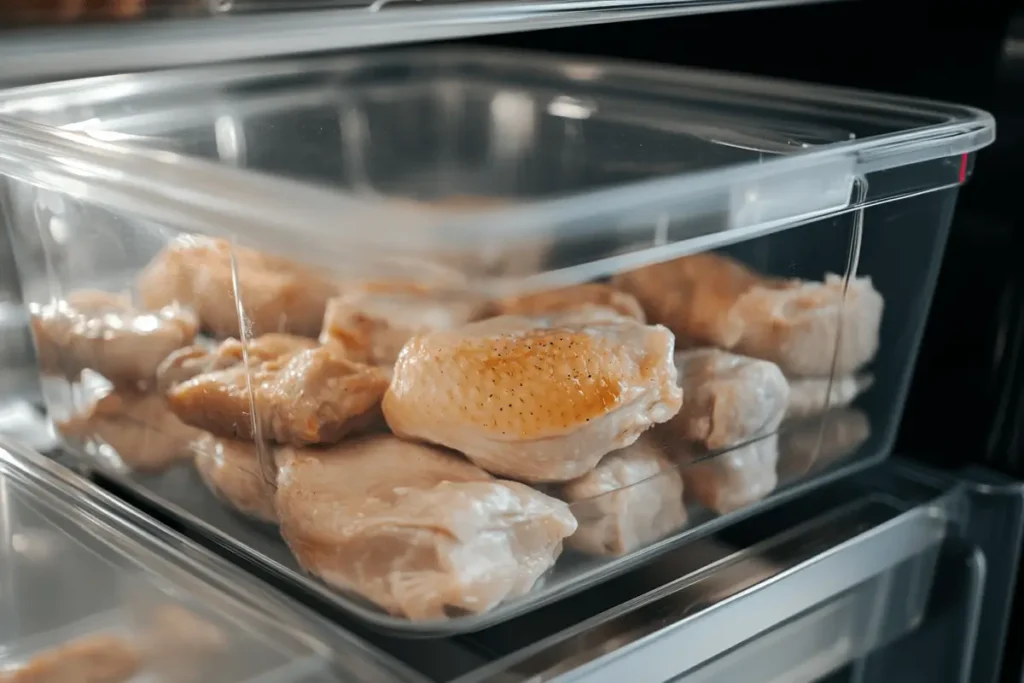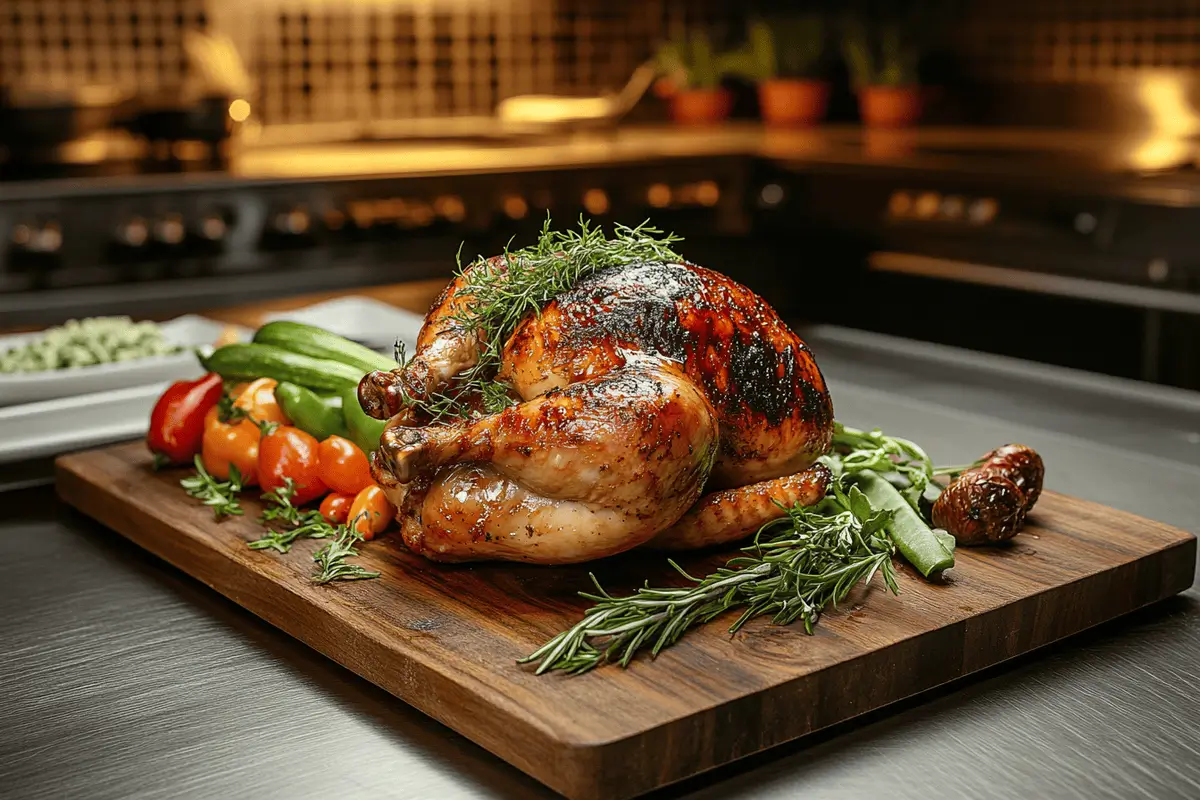Rotisserie chicken is a versatile, quick-fix meal solution that’s a lifesaver for busy days. But once you’ve enjoyed your first serving, you’re left wondering how to store the leftovers and how long they’ll remain safe to eat. In this comprehensive guide, we’ll explore the ideal ways to store your chicken, how to recognize when it’s no longer good, and even some creative ways to use leftovers.
Understanding Rotisserie Chicken Shelf Life
What Makes Rotisserie Chicken Convenient?
Rotisserie chicken is one of those kitchen staples that’s hard to beat. It’s ready-to-eat, loaded with flavor, and saves hours in meal prep. With its juicy, tender meat and a hint of seasoning, it pairs perfectly with countless side dishes. No wonder it’s a favorite go-to for families and individuals alike.
Beyond convenience, rotisserie chicken also packs nutritional value. It’s a great source of protein and essential vitamins. But to make the most of these benefits, it’s critical to understand how to store it safely.
What Affects the Shelf Life of Cooked Chicken?
The shelf life of leftover rotisserie chicken depends on several factors. First and foremost, temperature control plays a huge role. Cooked chicken left out at room temperature for more than two hours is a breeding ground for bacteria like Salmonella or Listeria. Always refrigerate your chicken promptly after the meal.
Handling practices are just as important. If the chicken was exposed to bare hands, cross-contaminated utensils, or dirty surfaces, its freshness might not last as long. Keeping it in airtight containers can help prolong its usability.
Importance of Safe Storage for Leftovers
Storing leftovers isn’t just about keeping food from going bad. It’s about protecting your health. Improper storage can lead to spoilage or even food poisoning. Bacteria grow rapidly at temperatures between 40°F and 140°F, also known as the “danger zone.”
To keep your leftover rotisserie chicken safe, ensure it’s stored at or below 40°F in the fridge. Proper storage doesn’t just save the meal but also gives you peace of mind knowing it’s safe to eat.
Ideal Storage Practices for Rotisserie Chicken
How to Store Rotisserie Chicken in the Fridge Safely
Storing leftover rotisserie chicken properly is key to maintaining freshness and safety. As soon as the meal ends, cool the chicken to room temperature, but don’t let it sit out for more than two hours. Place the chicken in an airtight container or wrap it tightly with plastic wrap or aluminum foil to avoid exposure to air, which can speed up spoilage.
If you’re storing individual portions, divide them into smaller containers. This makes reheating easier and prevents contamination when only one portion is needed. Store the chicken at 40°F or below in the refrigerator to keep it safe. For a deeper guide to preserving cooked chicken, you might find this leftover rotisserie chicken recipes resource helpful.

Signs of Spoiled Rotisserie Chicken
It’s essential to recognize when leftover chicken has gone bad. Spoiled chicken often has a sour or unpleasant odor that’s impossible to ignore. If you see grayish or greenish discoloration on the meat or a slimy texture, it’s time to toss it out.
Even if the chicken appears fine, consider how long it has been in the fridge. The general rule is to eat it within 3-4 days. After this period, bacteria like Listeria can start growing even at refrigeration temperatures, making it unsafe to eat.
Extending Shelf Life: Freezer Storage Tips
If you’re not planning to eat your chicken within the recommended time frame, freezing it is the best option. To freeze leftover rotisserie chicken, transfer it to freezer-safe bags or containers. Remove as much air as possible to prevent freezer burn.
Label the container with the date for easy tracking. Properly stored, chicken can last in the freezer for up to 4 months. When it’s time to eat, defrost the chicken overnight in the fridge or use the defrost setting on your microwave. Reheating frozen chicken should be done thoroughly to ensure safety.
How Long Is Leftover Rotisserie Chicken Good in the Fridge?
General Guidelines for Storing Leftover Rotisserie Chicken
So, how long is leftover rotisserie chicken good in the fridge? According to USDA recommendations, it should be consumed within 3-4 days when stored at 40°F or below. However, the exact time may vary depending on factors like storage methods and how quickly the chicken was refrigerated after cooking.
Keeping the chicken in an airtight container can help extend its shelf life, as it minimizes exposure to air and moisture. Make it a habit to label your leftovers with the date they were stored.
Impact of Storage Conditions on Shelf Life
Storage conditions directly affect how long your chicken stays fresh. The temperature of your refrigerator should consistently remain at or below 40°F. Crowded or poorly organized fridges can hinder air circulation, leading to inconsistent cooling and reduced freshness for perishable items.
Additionally, avoid placing warm chicken directly into the fridge. This can increase the internal temperature, potentially putting other food at risk. Let the chicken cool slightly, then store it promptly to maintain food safety.
What Happens After 3-4 Days?
Once the 3-4 day mark has passed, leftover rotisserie chicken becomes a potential health risk. Harmful bacteria, including Salmonella and Listeria, can grow even in chilled environments. Consuming spoiled chicken can lead to foodborne illnesses with symptoms like stomach cramps, nausea, and fever.
If you’re unsure whether the chicken is still good, it’s always better to err on the side of caution. As the saying goes, “When in doubt, throw it out.”
These sections provide actionable tips and clear guidance for storing leftover rotisserie chicken safely. Let me know when you’re ready for Part 4!
Ensuring Food Safety with Leftover Chicken
Common Food Safety Mistakes with Rotisserie Chicken
When dealing with leftover rotisserie chicken, avoiding common safety mistakes is crucial. One of the most frequent errors is leaving the chicken out at room temperature for too long. As a rule, food left out for more than two hours falls into the “danger zone,” where bacteria grow rapidly.
Cross-contamination is another significant concern. Using the same cutting board or utensils for raw and cooked chicken can lead to bacterial transfer. Always use clean tools and separate surfaces to keep your food safe.
Lastly, failing to store chicken properly in airtight containers can expose it to air and moisture, speeding up spoilage. When storing leftovers, prioritize safety by sealing them correctly and refrigerating them promptly.
How to Reheat Leftover Rotisserie Chicken Safely
Reheating leftover chicken requires care to ensure it’s both safe and tasty. The goal is to heat it to an internal temperature of at least 165°F. Use a food thermometer to check, especially if reheating large portions.
When reheating in the oven, cover the chicken with foil to retain moisture. For quicker results, you can use the microwave, but be mindful that uneven heating might leave some areas too cool. Stirring or rotating the chicken halfway through heating can help.
How to Tell If Chicken Is Safe to Eat
Even if it’s within the recommended storage period, leftover chicken should pass a quick safety check before eating. Look for signs like a sour smell, slimy texture, or unusual color. These are clear indicators that the chicken has spoiled.
Using a food thermometer is also a great way to ensure it’s been reheated properly. If you’re ever unsure about its safety, it’s best to discard the chicken. It’s better to waste a small portion than risk foodborne illness.
Creative Ways to Use Leftover Rotisserie Chicken
Popular Recipes Using Rotisserie Chicken
Leftover rotisserie chicken isn’t just for reheating and eating plain—it’s perfect for creating new meals! From hearty soups to refreshing salads, the options are endless. For instance, you can shred the chicken and use it in a quick chicken taco recipe or a comforting chicken pot pie. These recipes make use of every part of the chicken while keeping meals interesting.
For inspiration, check out this guide on leftover rotisserie chicken recipes, which includes ideas like salads, wraps, and casseroles.
Preventing Waste by Repurposing Chicken
To minimize waste, think creatively when repurposing your leftover rotisserie chicken. If you have small portions, add them to omelets, pasta, or rice dishes. Even the bones can be simmered to make a flavorful broth, perfect for soups or stews.
Batch cooking is another fantastic way to prevent waste. You can prepare several meals at once using your chicken, store them in the fridge or freezer, and enjoy them throughout the week. This not only saves time but also ensures that no part of your chicken goes unused.
For more ideas and meal prep tips, browse through our collection of quick and easy recipes.
Frequently Asked Questions (FAQs)
How Long Does Rotisserie Chicken Last in the Fridge After Purchase?
If stored correctly in the refrigerator, leftover rotisserie chicken remains safe to eat for up to 3-4 days. Always transfer the chicken to an airtight container or wrap it securely in plastic wrap or foil to keep it fresh. This prevents exposure to air and moisture, which can speed up spoilage.
Make sure to refrigerate the chicken promptly, ideally within two hours after purchase or consumption. If you’re wondering how long is leftover rotisserie chicken good in the fridge beyond this time frame, freezing it is the best option to extend its shelf life.
Can You Eat Rotisserie Chicken After 5 Days in the Fridge?
While it might still look okay, eating rotisserie chicken that’s been in the fridge for more than 4 days isn’t recommended. Bacteria can grow even in chilled environments, increasing the risk of foodborne illnesses. If you’re in doubt, it’s better to discard the chicken.
Freezing leftovers before the 4-day mark can prevent waste. Frozen chicken can stay good for up to 4 months and is a safer alternative to pushing fridge limits.
Is It Safe to Freeze Leftover Rotisserie Chicken?
Yes, freezing is an excellent way to preserve leftover rotisserie chicken. Ensure the chicken is placed in freezer-safe bags or containers, and remove as much air as possible to prevent freezer burn. Label the container with the date for easy reference, and consume it within 4 months for the best quality.
When reheating frozen chicken, let it thaw overnight in the refrigerator before warming it to an internal temperature of 165°F. This ensures it’s safe to eat and tastes just as good as fresh leftovers.
What’s the Best Way to Reheat Rotisserie Chicken?
The best way to reheat leftover chicken depends on your preference. The oven retains moisture and flavor, while the microwave is quicker but might dry out the meat. To avoid overcooking, cover the chicken with foil when reheating in the oven or add a small amount of water when using the microwave.
Regardless of the method, reheating the chicken to 165°F is crucial for safety. Always check the temperature with a food thermometer to ensure thorough heating.
Conclusion
Leftover rotisserie chicken is a kitchen hero, offering convenience and versatility. By understanding how long is leftover rotisserie chicken good in the fridge, you can safely store and enjoy it without worry. Always follow proper storage guidelines, keep an eye on spoilage signs, and use creativity when repurposing leftovers.
Whether you’re whipping up chicken tacos, hearty soups, or simple salads, there’s no shortage of ways to make the most of your rotisserie chicken. For more cooking inspiration, explore recipes tailored to rotisserie chicken leftovers and enjoy delicious meals that minimize waste.
Maximizing Leftover Rotisserie Chicken Shelf Life
Best Practices for Storing Leftover Chicken
To make the most of your rotisserie chicken leftovers, it’s essential to follow a few simple storage tips. Begin by refrigerating the chicken within two hours of cooking or purchase. Using airtight containers or tightly wrapping the chicken helps to lock in freshness and prevent spoilage.
Keep the refrigerator temperature at or below 40°F to slow bacterial growth. If you’re unsure about the fridge’s cooling efficiency, consider using a thermometer to ensure optimal conditions. Proper storage not only preserves flavor but also keeps your chicken safe to eat.
Using the Freezer to Extend Shelf Life
If you know you won’t finish the chicken within 3-4 days, freezing is your best bet. Freezing halts bacterial growth and significantly extends the chicken’s usability, allowing you to enjoy it weeks or even months later.
Before freezing, divide the chicken into portions for easy reheating. Wrap each portion in plastic wrap and place it in a freezer-safe bag or container. Remove as much air as possible to prevent freezer burn, which can affect taste and texture. Label the bags with the freezing date to track how long they’ve been stored.
When reheating frozen chicken, always ensure it reaches an internal temperature of 165°F. By freezing, you can extend the answer to how long is leftover rotisserie chicken good in the fridge well beyond the typical timeline.
Tips for Reducing Waste with Leftover Rotisserie Chicken

Plan Meals Around Leftover Chicken
One of the easiest ways to reduce waste is to plan meals that use leftover rotisserie chicken as the main ingredient. From chicken soups to wraps and casseroles, there’s no shortage of creative options. Repurposing leftovers not only saves time but also cuts down on grocery costs.
For example, shred the chicken to make tacos or combine it with fresh vegetables for a quick stir-fry. Planning meals in advance ensures you use every bit of your chicken before it spoils.
Using Bones and Scraps for Broth
Don’t overlook the chicken bones and scraps—they’re perfect for making homemade broth. Simmer the bones with water, herbs, and vegetables to create a nutrient-packed base for soups, stews, or rice dishes. This approach minimizes waste and gives your meals an added boost of flavor.
By fully utilizing your chicken, you can extend its value far beyond the main meal. The key to waste reduction is creativity, and with rotisserie chicken, the possibilities are endless.

